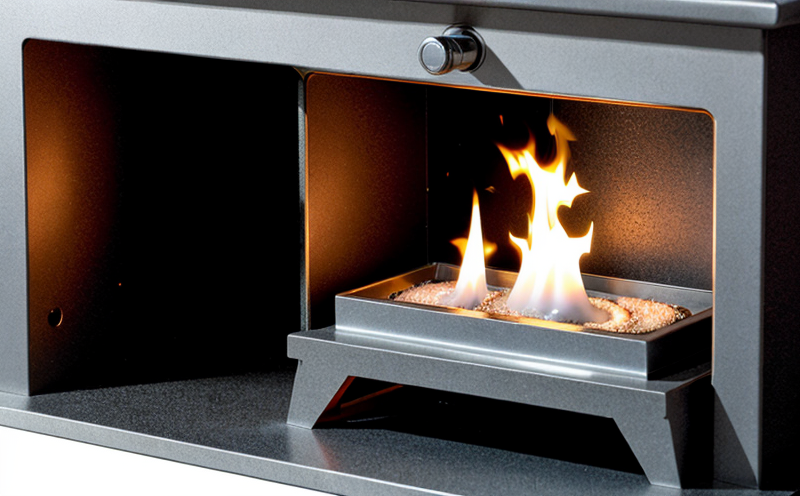Ignitability Testing of Composite Furniture Panels
The ignitability testing of composite furniture panels is a critical aspect of ensuring fire safety in residential and commercial settings. This service involves assessing the flame spread, heat release rate, and other parameters that determine how easily these materials ignite and propagate flames under controlled conditions. The importance of this test cannot be overstated; it helps manufacturers comply with stringent international standards and local regulations.
Composite furniture panels are widely used due to their durability, aesthetic appeal, and cost-effectiveness. However, the composition of these materials—often involving synthetic resins, fibers, and other additives—can make them more prone to ignition than traditional wood or metal-based products. The test protocols for ignitability ensure that manufacturers can demonstrate compliance with relevant fire safety standards.
The testing process typically involves preparing a representative specimen of the composite panel, placing it in a standard apparatus, and subjecting it to controlled heat sources. The apparatus used is designed to simulate real-world conditions while providing consistent results. This includes environmental factors like ventilation, oxygen levels, and humidity that can influence flame spread.
During the test, key parameters such as the time to ignition, flame spread rate, smoke density, and heat release rate are recorded. These metrics help determine the fire hazard of the material and guide manufacturers in selecting safer alternatives or improving existing designs. The results of these tests are then used by regulatory bodies, insurance companies, and end-users to make informed decisions about product safety.
The international standards that govern ignitability testing for composite furniture panels include ISO 13501-1, which specifies the method for determining the surface combustion characteristics of building materials. This standard is widely recognized and accepted in many countries around the world. Compliance with such standards not only ensures product safety but also enhances market access by meeting regulatory requirements.
Manufacturers who undergo ignitability testing can expect detailed reports that outline their products' performance against specified criteria. These reports are invaluable for quality assurance, R&D efforts, and marketing purposes. They provide a clear picture of how the material behaves in fire scenarios, which is crucial information for continuous improvement.
In conclusion, ignitability testing of composite furniture panels is an essential service that ensures product safety and compliance with international standards. By providing accurate and reliable test results, this service helps manufacturers produce safer products that meet market demands and regulatory expectations.
Scope and Methodology
The scope of ignitability testing for composite furniture panels encompasses a series of standardized procedures designed to assess the material's performance in various fire scenarios. The methodology follows internationally recognized standards such as ISO 13501-1, which provides detailed guidelines on how to conduct these tests.
- Preparation of Specimen: A representative sample is cut from the composite furniture panel according to specified dimensions and thickness.
- Apparatus Setup: The specimen is placed in a specially designed apparatus that simulates real-world conditions, including controlled ventilation and temperature settings.
- Heat Source Application: Controlled heat sources are applied to the specimen to initiate ignition and measure flame spread behavior.
- Data Collection: Various parameters such as time to ignition, flame spread rate, smoke density, and heat release rate are recorded during and after the test.
The methodology is designed to be rigorous yet reproducible, ensuring that results can be consistently replicated across different laboratories. This consistency is crucial for regulatory compliance and market confidence in product safety.
Once the testing is complete, a comprehensive report is generated detailing the specimen's performance under specified conditions. The report serves as a valuable tool for quality assurance teams, R&D departments, and procurement managers to identify areas of improvement or compliance gaps. It also provides critical data that can be used in marketing efforts to promote safer products.
Quality and Reliability Assurance
Ensuring the highest standards of quality and reliability is paramount when conducting ignitability tests on composite furniture panels. Our laboratory employs a robust quality management system that adheres to ISO 9001:2015, ensuring all processes are documented, reviewed, and continuously improved.
We use state-of-the-art equipment calibrated according to international standards such as NIST (National Institute of Standards and Technology) or equivalent national metrology institutes. This ensures precise and accurate measurements during the testing process.
Our team of experienced technicians undergoes regular training to stay updated on the latest methodologies and best practices. They follow strict protocols to minimize human error, ensuring that each test is conducted under consistent conditions.
In addition to internal audits and quality checks, we also participate in proficiency testing programs recognized by accrediting bodies like ANSI (American National Standards Institute) or equivalent international organizations. These programs validate our laboratory's capability to produce reliable results consistently.
The reliability of the tests is further enhanced through rigorous calibration procedures for all instruments used in the process. This ensures that every measurement taken during a test is accurate and traceable back to internationally recognized standards.
Our commitment to quality extends beyond just conducting accurate tests; we also ensure that our clients receive timely, detailed reports summarizing their product's performance. These reports are designed to be easily understood by both technical experts and non-experts alike, providing actionable insights into any areas requiring improvement.
International Acceptance and Recognition
- ISO 13501-1: This standard specifies the method for determining the surface combustion characteristics of building materials. It is widely recognized in many countries around the world, making it a key reference for ignitability testing.
- ASTM E84: Developed by ASTM International (formerly known as American Society for Testing and Materials), this standard provides another important framework for assessing flame spread on vertical surfaces.
- EN 13501-1: This European standard aligns closely with ISO 13501-1, ensuring compatibility between different regions' requirements.
- IEC 60332: Relevant for electrical appliances and equipment, this standard ensures that materials used in these products are flame-retardant.
The acceptance of these standards varies by region, but they form the backbone of fire safety regulations globally. Compliance with these standards enhances a product's marketability, facilitates international trade, and demonstrates a commitment to public safety.





